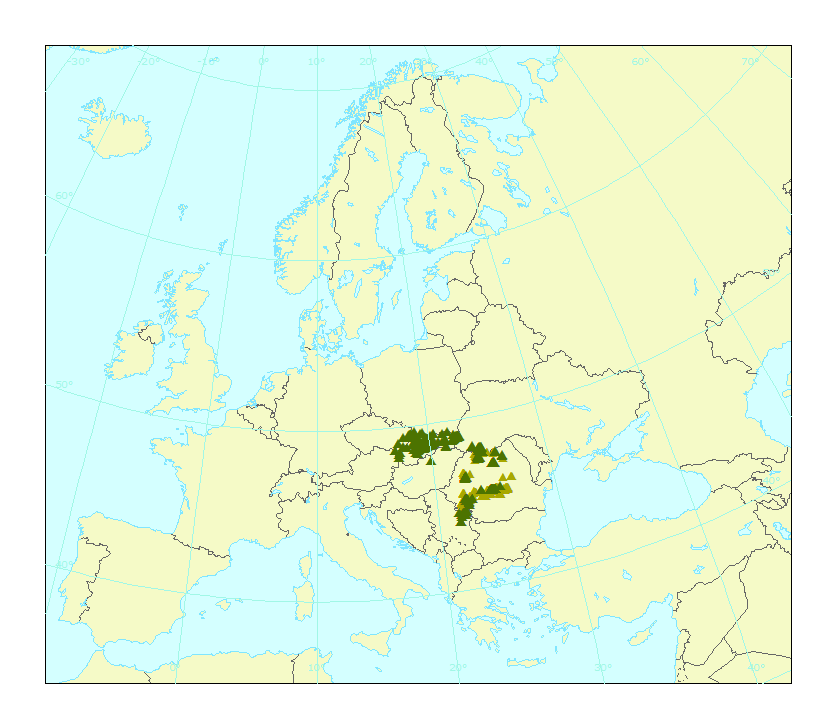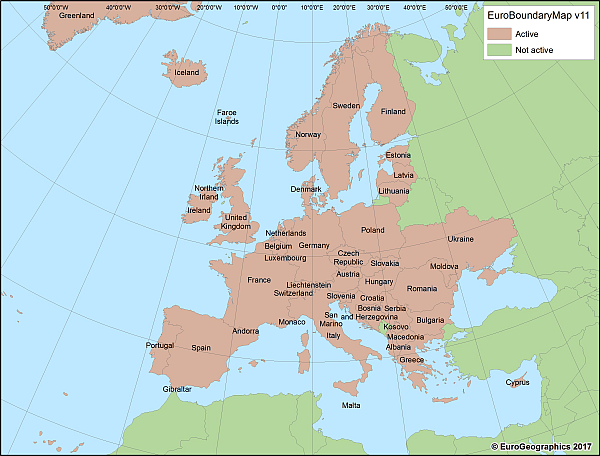Ukraine
Type of resources
Available actions
Topics
INSPIRE themes
Keywords
Contact for the resource
Provided by
Years
Formats
Representation types
Update frequencies
status
Scale
Resolution
-

This data set represents the boundaries of the area of interest where activities and researches promoted by the Carpathian Convention Parties take place. It consists of the area, extended with a 50 km buffer zone, identified in the Carpathian Environment Outlook (KEO) described in the 2010 EEA Report No 6/2010 "Europe´s ecological backbone: recognising the true value of our mountains" (https://www.eea.europa.eu/publications/europes-ecological-backbone). The area covered within these boundaries includes part of EU countries, Czechia, Hungary, Poland, Romania, Slovakia, an EEA cooperative countries, Serbia and Ukraine. The boundaries delimitation was proposed and agreed by the signatories of the Partnership agreement, the EEA and the Secretariat of the Carpathian Convention (SCC).
-

The forest fragmentation dataset detects and describes the geometry and the connectivity of forests coverage. This dataset, developed based on the methodology of the European study "Forest landscape in Europe: Pattern, Fragmentation, and connectivity" (Estreguil et al., 2012), has been calculated for the Carpathian forest included within the Carpathians Environment Outlook (KEO) buffer boundaries as described in the 2010 EEA publication "Europe´s ecological backbone: recognising the true value of our mountains".
-

The virgin forest inventory data set includes the location (point) of the last virgin forests identified by each Carpathians Convention Member, namely Czechia, Hungary, Romania, Serbia, Slovakia, and Ukraine. The data set does not include plots from Poland, since no official inputs have been submitted yet. An additional layer presents the quasi virgin forest plots provided by Romania. The virgin forest inventory inputs were collected and validated in 2019. The attribute table indicates, when available and along the virgin forest location, additional information as the official name, size, the county to which it belongs, altitude, level of protection, the forest type according to the national classification and its correspondence with the European Nature Information System classes (EUNIS). The Carpathians area of study is delimited by the Carpathian Environment Outlook (KEO) boundary.
-

EuroBoundaryMap provides a European geographic database for administrative and statistical regions that will be maintained at the source level by the National Mapping and Cadastral Agencies (NMCAs), and by providing harmonized access conditions for this geographic information within the framework of EuroGeographics. EBM (1:100 000) offers the combined strength of detailed European administrative units and linkages to the corresponding LAU and NUTS codes. The product EBM v11 is a full update of all countries. More details are available in EBM_v11_Specification.pdf
-

This vector dataset presents the delineation of the Emerald Network Areas of Special Conservation Interest for the reference year 2016. The dataset covers non-EU Contracting Parties and Observer States to the Bern Convention. The dataset includes both adopted and candidate sites. For this particular dataset, there are only adopted sites in BY, CH and UA. The Emerald Network is an ecological network made up of Areas of Special Conservation Interest. Its implementation was launched by the Council of Europe as part of its work under the Bern Convention, with the adoption of Recommendation No. 16 (1989) of the Standing Committee to the Bern Convention. The objective of the Emerald Network is the long-term survival of the species and habitats requiring specific protection measures listed respectively in Resolution No. 4 (1996) and Resolution No. 6 (1998) of the Standing Committee to the Bern Convention. The Network is to be set up in each Contracting Party or observer State to the Convention. It thus involves all the European Union member States, some non-Community States and a number of African States. As a Contracting Party, the European Union contributes to the Emerald Network with its Natura 2000 sites.
-

EuroBoundaryMap provides a European geographic database for administrative and statistical regions that will be maintained at the source level by the National Mapping and Cadastral Agencies (NMCAs), and by providing harmonized access conditions for this geographic information within the framework of EuroGeographics. EBM (1:100000) offers the combined strength of detailed European administrative units and linkages to the corresponding LAU and NUTS codes. This metadata refers to the version 12 of EBM, which is a full update of all the countries. For more information about the data product specifications and changes with respect to the previous version of this dataset (EBM v11), please refer to the documents EBM_v12_Specification.pdf, EBM_v12_TechnicalGuide.pdf and EBM_v12_Changes.pdf provided with the dataset (Documents.zip) This dataset is only to be used internally in the EEA, for the purposes and under the conditions stated under the "Resource Constraints" elements of this metadata file and on the document "LicenseConditions.pdf" provided with this dataset. This metadata has been slightly adapted from the original metadata file provided by EuroGeographics and is to be used only for internal EEA purposes. For reference, the metadata file created by EuroGeographics is provided together with the dataset ("Metadata_EBM_v12.xml" within the "Descriptions_Metadata.zip")
-

The naturalness dataset is calculated as a species assemblages likeliness over the forest coverage. It has been produced for the entire Carpathian region included within the Carpathians Environment Outlook (KEO) buffer boundaries as described in the 2010 EEA publication "Europe´s ecological backbone: recognising the true value of our mountains".
-

Tracking land cover changes using remotely sensed data contributes to evaluating the impact of human activities on the environment. The first GlobCover map successfully demonstrated the usefulness of MERIS time series for operational land cover observation. Jointly supported by theEuropean Space Agency and the European Environment Agency, the GlobCorine project builds on the GlobCover findings and aims to make the full use of the MERIS time series for frequent land cover monitoring at the pan-European scale. Such an automated approach at 300 m will not identify landscape patterns as precisely as the Corine methodology, but it will significantly shorten the time response and expand the coverage. First, the automated GlobCover processing chain is adjusted towards a more land use oriented classification, compatible with the Corine typology. Second, an automated statistically-based algorithm is proposed to enable to monitor key land dynamics on a regular basis.
-

EuroBoundaryMap (EBM) provides a European geographic database for administrative and statistical regions that will be maintained at the source level by the National Mapping and Cadastral Agencies (NMCAs), and by providing harmonized access conditions for this geographic information within the framework of EuroGeographics. EBM (1:100000) offers the combined strength of detailed European administrative units and linkages to the corresponding LAU and NUTS codes. This metadata refers to the version 2019 of EBM, which is a full update of all the countries. The dataset is provided both in a full Europe dataset (Data_FullEurope) and divided by countries (Data_Countries) in GDB and SHP formats, compressed (ZIP) and not compressed. EBM 2019 contains the matching with the NUTS regulations No 2016/2066 (NUTS 2016) and refers to the administrative situation as it was in each country on 1 January 2018 (reference date). The EBM Full Europe database is containing Kosovo (KS) as an independent country, but the individual dataset of Serbia (RS) covers also Kosovo following Serbian legal position. For more information about the data product specifications and changes with respect to the previous version of this dataset (EBM v12), please refer to the documents EBM_2019_Specification.pdf, EBM_2019_TechnicalGuide.pdf and EBM_2019_Changes.pdf provided with the dataset under the folder "Documents" and "Descriptions_Metadata" under "Documentation" link. IMPORTANT NOTE: This dataset is only to be used internally in the EEA, for the purposes and under the conditions stated under the "Resource Constraints" elements of this metadata file and on the document "LicenseConditions.pdf" provided with this dataset under "Documentation" link. This metadata has been slightly adapted from the original metadata file provided by EuroGeographics and is to be used only for internal EEA purposes. For reference, the metadata file created by EuroGeographics is provided together with the dataset ("Metadata_EBM_2019.xml" within the "Descriptions_Metadata").
-

EuroBoundaryMap provides a European geographic database for administrative and statistical regions that will be maintained at the source level by the National Mapping and Cadastral Agencies (NMCAs), and by providing harmonized access conditions for this geographic information within the framework of EuroGeographics. EBM (1:100000) offers the combined strength of detailed European administrative units and linkages to the corresponding LAU and NUTS codes. This metadata refers to the version 2020 of EBM, which is a complete new update of the EBM product based on the new NUTS2016 regulation. The basis for the update was the previous release EBM 2019. The dataset is provided both in a full Europe dataset (Data_FullEurope) and divided by countries (Data_Countries) in GDB format. EBM 2020 contains the matching with the NUTS regulations No 2016/2066 (NUTS 2016) and refers to the administrative situation as it was in each country on 31 January 2018 (reference date). Names of administrative units and levels are stored with Unicode character set as well as standard ASCII. Considering the user requirements, it can also be distinguished between land and water parts of administrative units within EuroBoundaryMap.Territorial sea areas are included for a number of countries as an optional feature. This comprises territorial waters assigned to administrative units on lowest national level as well as territorial waters, which are directly administered by the national government. The definition of the territorial sea strictly follows the United Nations Convention on the Law of the Sea. All territorial sea areas are attributed as coastal waters. For more information about the data product specifications and changes with respect to the previous version of this dataset (EBM 2019), please refer to the documents EBM_2020_Specification.pdf and EBM_2020_Changes.pdf provided with the data set under the folder "Documents" and "Descriptions_Metadata" under "Documentation" link. The EBM Full Europe database ("EuroBoundaryMap_2020") does not contain either Kosovo (KS) as independent country or Serbia (RS) including Kosovo following Serbian legal position). "EuroBoundaryMap_2020_optionRS" includes only the individual data set of Serbia with Kosovo following Serbian legal position. "EuroBoundaryMap_2020_optionKS" includes only the individual data sets of Serbia and Kosovo, the latter as independent country. It is advised to use the code XK instead of KS for Kosovo. IMPORTANT NOTE: This data set is only to be used internally in the EEA, for the purposes and under the conditions stated under the "Resource Constraints" elements of this metadata file and on the document "LicenseConditions_EBM.pdf" provided with this dataset under "Documentation" link. This metadata has been slightly adapted from the original metadata file provided by EuroGeographics and is to be used only for internal EEA purposes. For reference, the metadata file created by EuroGeographics is provided together with the dataset ("Metadata_EBM_2020.xml" within the "Descriptions_Metadata") as well as the national metadata stored under each corresponding country folder in "Descriptions_Metadata" provided together with the dataset under the link "Documentation".
 RUC Geo-Data catalogue
RUC Geo-Data catalogue